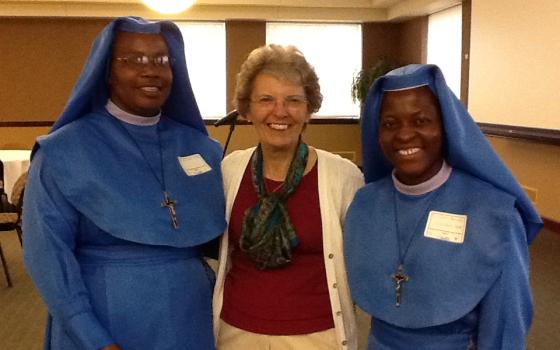In early July Region XI of LCWR held a bi-annual conference for all the sisters of Minnesota, South and North Dakota and Wyoming. Tom Fox and I were invited to plan a day-long program around the new NCR project: Global Sisters Report, and we were excited over their enthusiasm. The sisters also wanted practical ways they could make connections between themselves and Global South sisters.
Tom began by inspiring the sisters to create a new vision of religious life as a global sisterhood, reminding them that media is the necessary way of engagement. He projected the Global Sisters Report website so the sisters could see for themselves how valuable their participation is in keeping this vision alive.
He also shared his assessment of the current issues between LCWR leadership and the Vatican office of CDF. He affirmed without a doubt that the sisters’ contemplative and dialogical methods used in their annual assemblies for making decisions are congruent with Vatican II and therefore need to be trusted. Sisters have always operated at the edges and this leadership it is what is needed in the church.
Two other highlights of the day were a panel of sisters sharing the joys and challenges of their congregations connecting with global south sisters, and meeting sisters from the Nigeria working in the archdiocese. Sr. Kerry O’Reilly, OSB of St Joseph, Minn., told about the formation work Benedictine sisters are doing in China; Sr. Bea Eichten, OSF, of Little Falls, Minn., described their relationship with a local congregation of Franciscan sisters in Kenya; Sr. Suzanne Stahl, SMP of Valley City, N.D., shared her mission experiences and issues of their province of in Cameroon, and Sr. Janice Klein, PBVM of Aberdeen, S.D., told of the developing relationship between Aberdeen Presentation Sisters and a province of another Presentation group in Zambia. Many of the participants had no idea of region members engagement with sisters in the Global South. They also had opportunity in their table groups to share their own experiences.
The afternoon program included my presentation about needs of sisters in the Global South that move sisters to come to the U.S. Congregations are sending sisters because they lack adequate resources to support formation and education of their sisters. As do other immigrants, they tend to see the United States as a place where they can find work and send funds back home. Needs of dioceses and parishes here in the U.S. are pushing some bishops to see sisters from the Global South as economic answers to pastoral and education needs.
At the end of the presentation, two sisters of the Immaculate Heart of Mary, Srs. Xavier Ezeokoli and Rita Salami from Enugu, Nigeria, shared their story of coming to the archdiocese. Their congregation has 12 communities in the United States. Seven community members in Minneapolis are working in various ministries, one a program called Helping Hands, offering services to the poor of the area. After searching for sisters locally and finding none, the director received permission from the local bishop to invite the Nigerian sisters to this work. The sisters’ presence in the archdiocese came as great surprise to the assembly. Their ministries have not allowed for much interaction with others, even though they do attend some diocesan events. Unfortunately, invisibility of sisters from the Global South is a common experience around the country, but eyes were opened here. Global South sisters are on our doorstep and we need to become aware of them and make them welcome into the religious life of our country.
[Joyce Meyer, PBVM, is international liaison for Global Sisters Report.]

